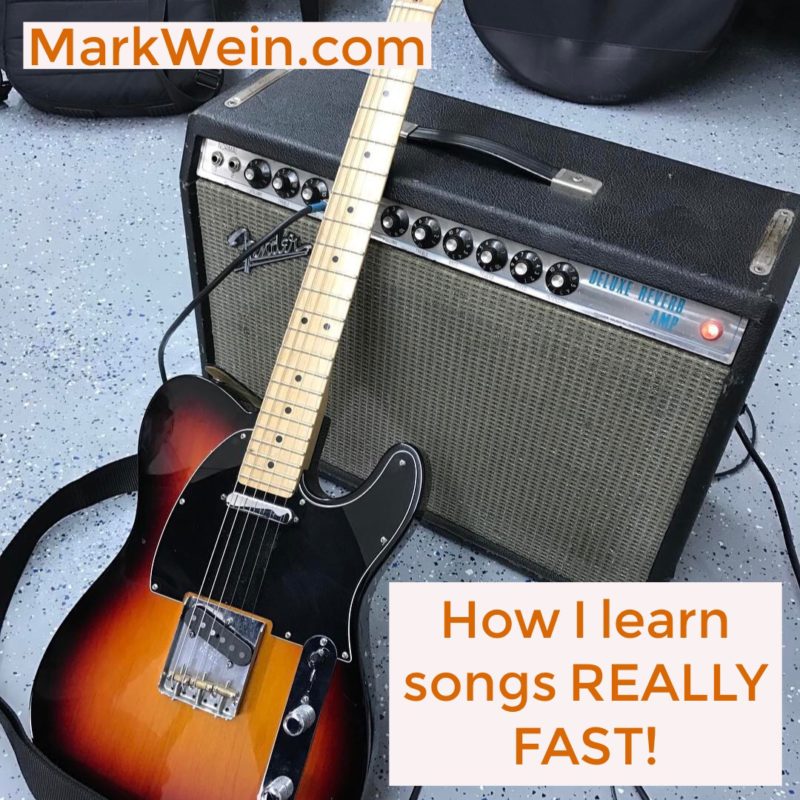This week the cover band that I play in is doing five nights in a row at the Orange County Fair (more info here although this is just for the first of the five dates) and as we usually try to do when we play back to back nights in the same venue we attempt to play as many different songs from our 150 song repertoire as possible. This is a lot of back to back nights so I’ll eed to have as many of these songs ready as possible. Realistically we’ll play 40-50 songs a night and we probably have a “regular” rotation of about 80 songs. The rest live on the list until something like this happens.
Some of those tunes we haven’t played in years so I am cramming to remember songs and even learning songs that are on the list from my “band hiatus” of 2007-2009. I’m also cleaning up parts to songs we play regularly that I might not have learned very accurately in the first place. Since it’s a trio I have a lot of leeway as to what I should play and there is quite a bit of space for me to fill since my “area of responsibility” goes from “guitar parts” to “everything that isn’t bass, drums and vocals”.

One thing that I learned a long time ago is that it is best to break songs down into more digestible chunks that I can more easily understand. Instead of trying to learn a song as one complete item one bit after another I learn the major “component” parts of the song first and then fill in the other parts later. Instead of making full lead sheets or charts of each song, I’ve found it easier to write out a roadmap of each section with chord progressions, notable rhythms and brief notes about things that are specific to each section.
This mess is an example:
Here is the original recording for your reference:
Keep in mind that no one needs to be able to read this but me and usually, once I’ve gone to the trouble of writing it out like this I don’t even need to do that. So I don’t really worry about making it look nice, just legible enough for me to read.
Let’s break it down:
Intro:
This is the first 8 measures of the song. I have already learned the intro lick so I will be playing that, but this reminds me of what the chord progression should be and how many times it repeats. Sometimes I’ll write total numbers of bars in. but this is pretty simple to keep track of.
Verse 1:
I can see that the verse is made up of the same four chords as the intro and that four-bar phrase repeats four times for a total of 16 bars. I’m very familiar with this song so I know what the rhythm is here but if it were something specific that needed to fit with the rest of the band I might write that out as well. Getting used to feeling four-bar phrases in pop and rock music is hugely important and when you write out the lowest common denominator phrase of a repeating section like this it gets you used to feeling the phrase and not the measure, which helps you keep track of where you are in the song and also helps you play more musically in the overall picture.
Chorus 1:
This is an eight-bar section in my mind. If you really look it is two four-bar phrases that just end on a different chord each time but the way it feels when I perform it (I’m also singing this song) leads me to write it this way.
Verse and Chorus 2:
This is where we start really seeing the “modular” nature of many pop songs. Why write it out again when I already have? It also reminds me that it is the same and not a unique section of the song. The only difference is the addition of two more bars of D at the end of the chorus as it leads into the refrain. I have that noted along with the lyrics as a reminder of what is going on at that point that makes it special.
Breakdown and Bass Solo:
The breakdown section that serves as a sort of bridge before we return to our verse/chorus/refrain structure has a specific guitar lick that I have memorized over a repeated G bass note (or “pedal tone”). Then there are four more measures of the original chord progressions where the bass plays a line all by itself before…
Verse 3 and Chorus 3:
Yep, same as the second verse and chorus complete with the extra two bars leading to the…
Refrain and Outro:
This tells me that we play the “Sha-la-la” refrain again, but for 16 bars instead of 8 like the first time and we’ve made the intro into an ending, which for some reason always leads into the song “Hard to Handle” by Otis Redding/Black Crowes.
This is the basic structure that I’ll work with. In reality, if people are dancing we will put a guitar solo over the verse and chorus progressions after the third verse, Dominic (our drummer) might sing a verse he’s added to the song and then we do the “refrain/outro/segue” to end the song. I didn’t want to complicate the original page for you guys, though so I left all that out.
If I need to learn a LOT of songs in a short amount of time I might make a little book like this but usually just the process of making these charts and a quick look back before the gig gets the music in my head pretty well.









